UPI for Small Shops in India You know, sometimes revolutions don’t come with loud slogans or dramatic headlines. They just quietly sneak into our lives until one day you look around and realize, wow, things have changed. For me, that quiet revolution is UPI. And the real winners? Not just the fancy tech startups in Bengaluru or the big retail chains in Delhi, but the small shops—the kirana stores, chaiwalas, paan stalls—that literally keep India running.
Let me be honest here: I didn’t think much of UPI when it first came. I thought, Okay, just another app, another fancy payment thingy. But over the years, especially by 2025, it’s become impossible to ignore. You step out to buy vegetables, tea, or even a 10-rupee biscuit packet, and there’s a QR code waiting for you. Sometimes the QR code board looks older than the shop itself.
My First Encounter with a QR Code Tea Stall
I still remember, sometime around 2019, I walked up to a tea stall in Pune. Ordered a cutting chai, reached into my wallet, and the chaiwala goes, “UPI hai kya?” I swear, I almost spilled my tea. A chaiwala asking me for digital payment? Back then it felt strange. Today in 2025, it’s the most normal thing ever. Now, chaiwalas actually prefer UPI. No loose change drama, no “arre kal de dena” excuses. You sip your tea, scan the code, and it’s done. The chaiwala I know near my office in Delhi even says, “Bhai, abhi toh 70% log UPI dete hain. Cash toh sirf buzurg log hi dete hain.” That’s how normalized it has become.
Why UPI for Small Shops in India Needed This Shift
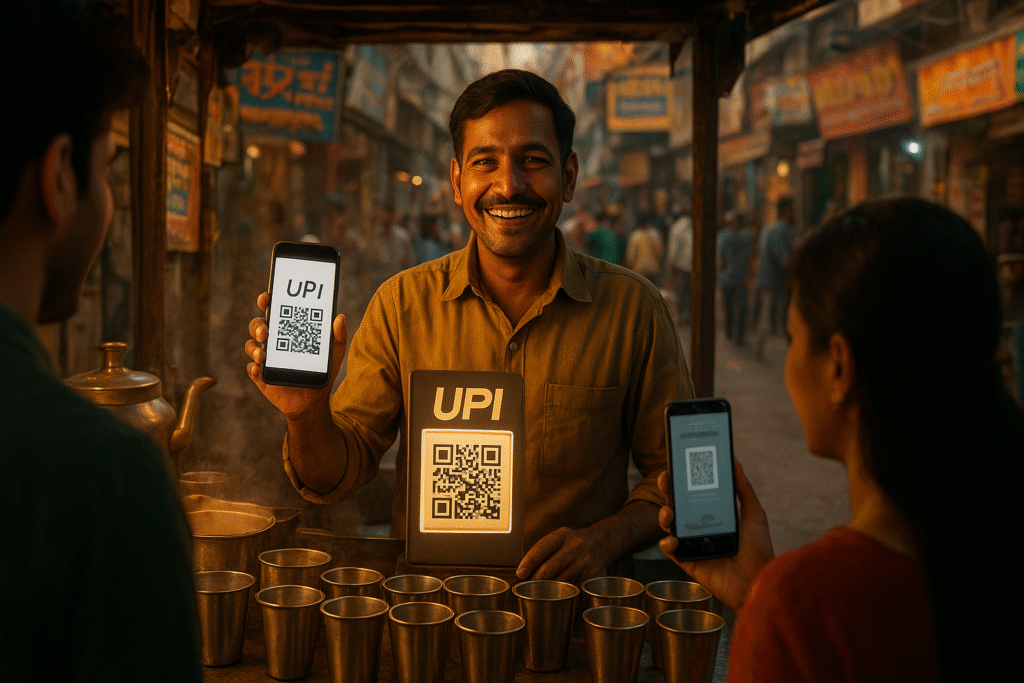
Let’s be real: small shops in India have always been the backbone of our economy. Whether it’s your local kirana, the paan wala who knows your cigarette brand better than you, or the fruit vendor who gives you that extra lemon “free”, they’ve all survived on trust and cash.
But cash had its problems.
- Shopkeepers losing money because of fake notes.
- Constant headache of keeping coins and change.
- No proper records of sales, which meant no loans, no growth.
And let’s not forget the awkward “Udhaar likh lo” situations. My neighborhood kirana guy had a whole register full of unpaid dues. Half the time, he would argue with customers: “Bhai, aapne toh 500 diye hi nahi.” With UPI, all of this is changing—and honestly, it’s making life easier for both sides.
Stories That Stuck with Me
I’ll share a few stories that really made me appreciate how UPI is helping the “little guys.
The Tea Seller Who Became a Mini-Entrepreneur
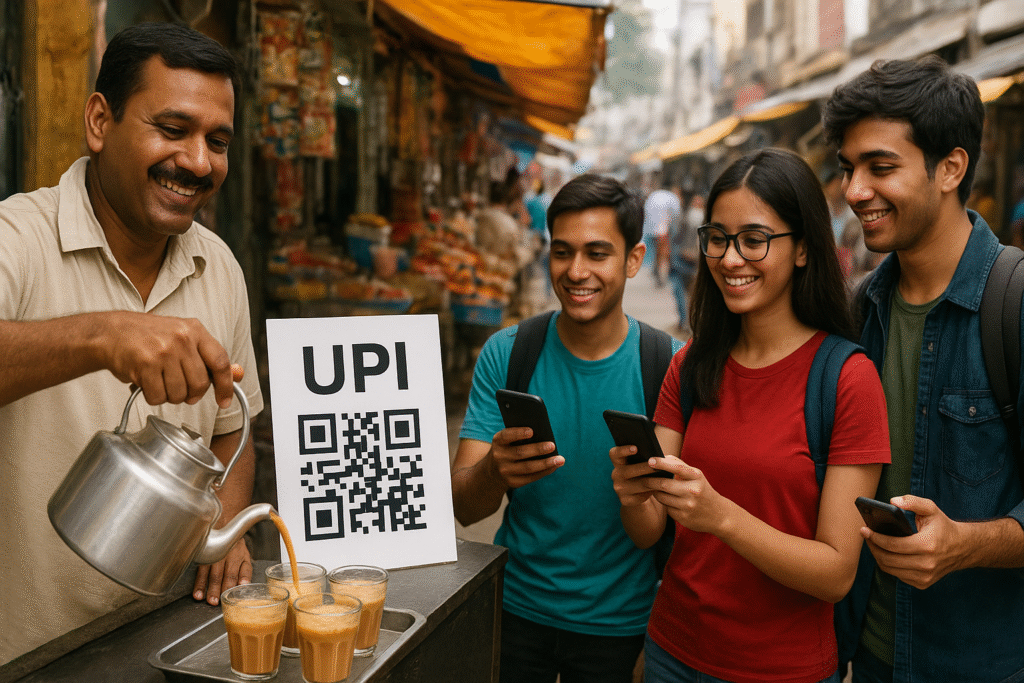
There’s this guy, Ramesh, in Lucknow. He runs a tiny tea stall outside a college. In 2022, some students told him to put up a QR code. At first, he didn’t care. But slowly, he saw students paying digitally and skipping the whole coin drama. By 2023, he was getting half his income via UPI.
Fast forward to 2025? This man literally advertises “Pay by UPI and get Rs. 5 off on 2 cups of chai.” Tell me that’s not smart business. He even used his UPI records to get a small loan and bought a second stall near the railway station. From a street vendor to a two-stall businessman—all because of digital payments.
The Kirana Lady Who Outsmarted the “Udhaar” Game
Then there’s Anita in Pune. She runs a kirana store, and earlier her shop was full of small chits of paper and a thick notebook of unpaid credits. People used to argue, “We already paid.” She had no proof. Now she just sends a UPI link on WhatsApp. Simple. Customer clicks, pays, done. No confusion, no fights. She even tracks which products sell the most because her merchant app shows her weekly reports. A small kirana behaving like a mini Big Bazaar—that’s what UPI has done.
A Farmer’s Market That Went Digital
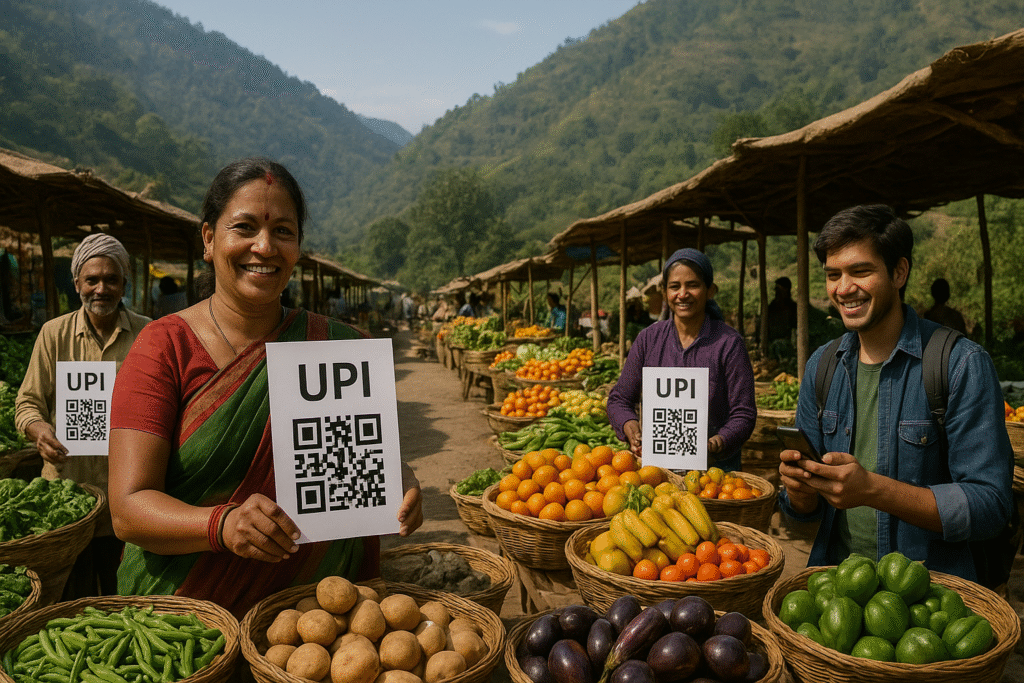
Last year, I visited a small farmers’ market in Uttarakhand. Fresh vegetables, fruits, local cheese—all in baskets. And guess what? Every single vendor had a laminated QR code hanging from their basket. Some even had “Google Pay Accepted” painted on cardboard.
One farmer told me, “Earlier, I wasted 30 minutes finding change. Now, I get money instantly in my account. I can go home early to my kids.” That hit me. UPI for Small shops in India smarter—it’s giving people back their time.
What Exactly Changed for Them?
The magic is not just “digital money”. It’s bigger:
- Credit Access: Banks used to laugh at small vendors. “No records, no loan.” Now, UPI transactions serve as proof of income. Suddenly, micro-loans are possible.
- Speed: More customers served in less time. No waiting around for coins or signatures.
- Customer Loyalty: Discounts, cashback, even loyalty points—small shops are playing big games.
- Peace of Mind: No fear of theft, no fake notes, no messy registers.
Basically, shopkeepers are doing more with less. And customers? We just love the convenience.
The Rough Side (Because It’s Not All Sunshine)
Now, let’s not romanticize this too much. There are still problems.
- Some shopkeepers are still not tech-savvy. I’ve seen uncles who press “cancel” by mistake.
- Rural areas sometimes suffer from poor internet, making digital payments frustrating.
- And yes, scams exist. Fake payment screenshots, fraud calls—many shopkeepers got burned.
But here’s the thing: every revolution has its hiccups. Just like people learned how to use ATMs back in the day, shopkeepers are learning to handle UPI smartly. Awareness campaigns, simpler apps, and real-time verification are slowly solving these issues.
Apps That Became Lifelines
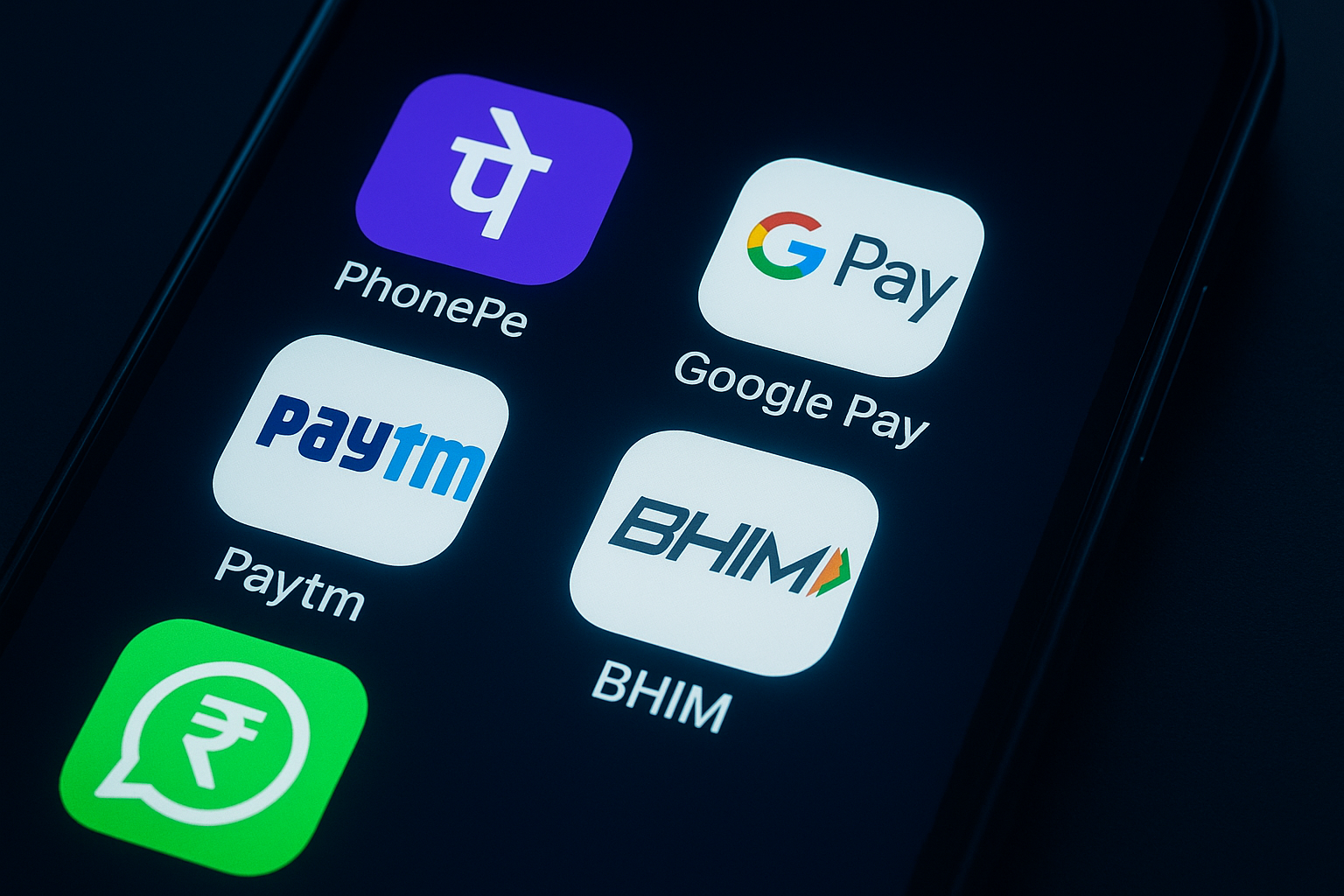
By 2025, a few apps have become absolute lifelines for small merchants:
- PhonePe & Google Pay: For quick payments and offers.
- Paytm: Still popular among vendors, especially for recharge and wallet features.
- BHIM UPI: Government’s simple, no-nonsense app in local languages.
- WhatsApp Pay: A personal favorite for kiranas—sending a payment link on chat is just too easy.
These apps have basically turned smartphones into mini cash registers.
The Bigger Picture
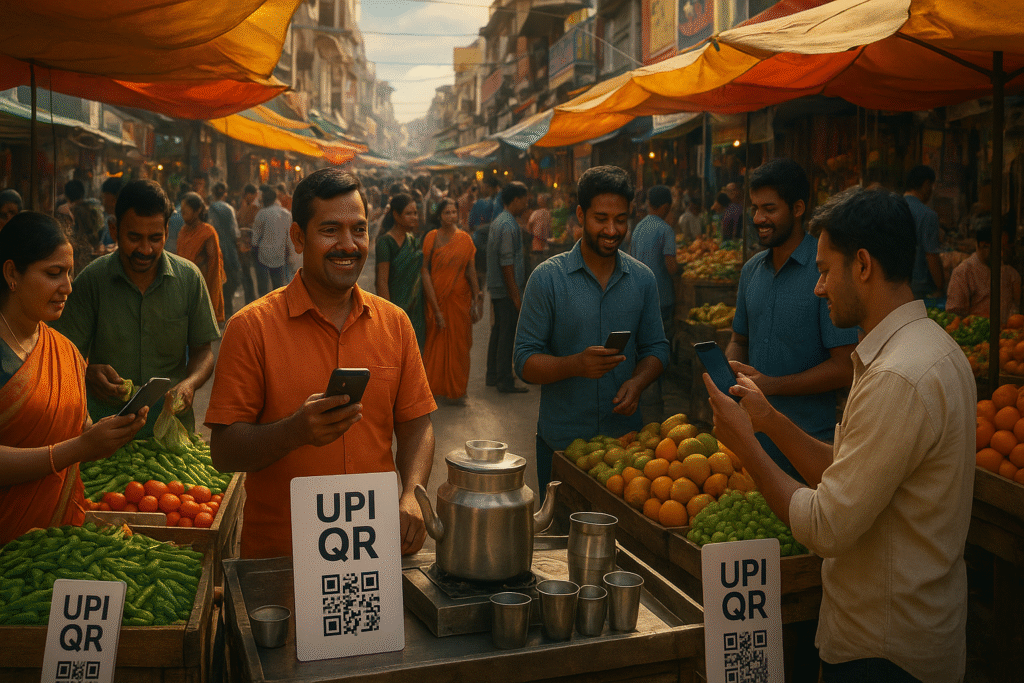
What I love most about this UPI wave is how it’s reshaping India’s economy at the grassroots level. Earlier, digital India meant flashy startups or online shopping. Now it means a paanwala in Patna, a fruit seller in Jaipur, and a fisherman in Kerala being part of the same digital economy.
It’s transparency. It’s inclusion. It’s dignity. For decades, small vendors were invisible in the formal economy. No records, no loans, no recognition. UPI pulled them into the light. And that, to me, is nothing short of revolutionary.
Looking Ahead: Beyond 2025
I don’t think this story stops here. In the next few years, we might see:
- Shops getting AI-powered tips: “Stock more chips on weekends, they sell faster.”
- Kiranas seamlessly joining e-commerce platforms, taking local orders online.
- More women entrepreneurs stepping up, because digital tools make business easier and safer.
- Maybe even cashless rural markets, where coins and notes become rare.
Sounds futuristic? Maybe. But honestly, I never thought I’d be paying 10 rupees for chai with my phone either. And look at us now.
Final Thoughts
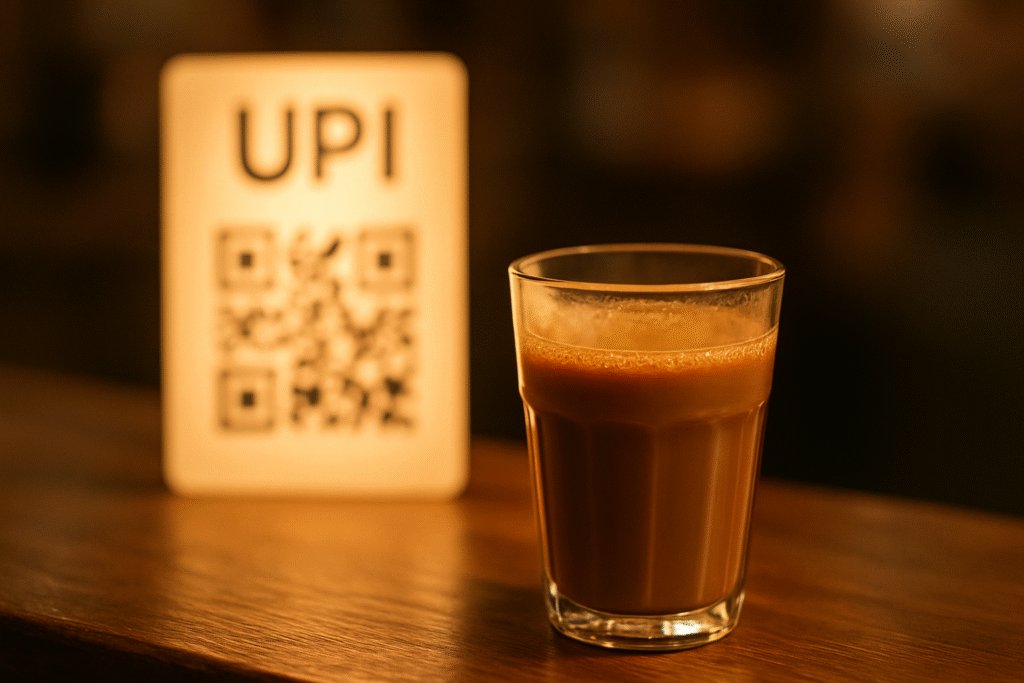
I’ll say this: UPI has done something remarkable in India. It has made the smallest shops smarter, more confident, and more ambitious. It has taken people who were stuck with coins and notebooks, and given them access to banking, loans, records, and growth. And the best part? It feels natural. Nobody forced it. Customers wanted it, shopkeepers adapted, and suddenly it became everyday life.
So next time you’re standing at a tiny tea stall, sipping hot chai and scanning that little QR code—pause for a second. You’re not just making a payment. You’re part of a silent revolution that’s rewriting India’s story, one small shop at a time.
“India’s digital story is being written one small shop at a time.”



